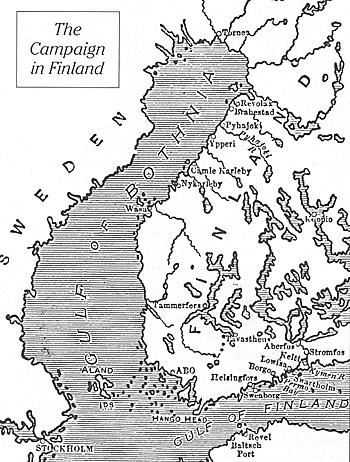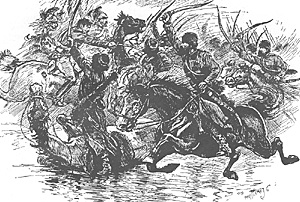The war was brief but eventful. If success finally rested
with Russia, notwithstanding hard-fought Swedish victories in the
field, it was because the policy of King Gustavus made the efforts
of his generals unavailing, and because a weak and irresolute
commandant prematurely yielded the chief fortress of Finland and
of the Swedish crown to the invaders. Sweaborg, a mass of granite
forts and ramparts, built on a group of five rocky islands, in the
midst of the sea, was till then supposed to be impregnable. It was
the chief arsenal both of the Swedish armies in the north end of the
kingdom and of the flotilla maintained for operations in the shallow
waters of the gulfs of Bothnia and Finland. In war time a fleet
stationed there was already at the gates of St. Petersburg, and could
blockade and menace the Russian capital. No wonder that its
possession had long been coveted by the Czars.
By the secret articles of the Treaty of Tilsit, it was agreed
between Napoleon and the Emperor Alexander that Russia should
take possession of Finland. The ministers of the Czar proceeded at
once to press various complaints against the conduct of the court
of Stockholm. Gustavus Adolphus, the king of Sweden, was
warned by friends that he was to be attacked in Finland but he
obstinately refused to believe that there was anything more serious
than diplomatic friction with Russia.
In any case he expected that there would be no war till the
summer But the Russians had planned a winter campaign. In the
summer they would have had to reckon with the opposition of the
Swedish fleet, probably reinforced by a British squadron but in the
winter months, the frozen northern seas made naval warfare
impossible. It is true that on the land the intense cold would add to
the difficulties of campaigning but the advantage of being secure
from an attack by sea was so great that the winter campaign was
decided upon.
The banks of the frozen river Rymen, which then formed
the frontier of Swedish Finland, were only held by a feeble line of
detached posts, the usual guard maintained in time of peace for
Customs and police purposes, and nothing more.
On the Russian side of the frontier in the first half of
February, 1808 16,000 men were concentrated under the command
of General Count Bouxhoevden. The troops were specially
equipped for winter campaigning. The infantry were provided with
snow-shoes, the guns and stores were mounted on sledges. As soon
as everything was ready war was declared, and the little army of
invasion crossed the Kymen in three columns at Aberfos, Stromfos,
and Keltis.
The Swedes were in no position to make an effective
resistance on the frontier. Everywhere they fell back before the
Russians. The first blood was spilt at Aberfos, where the Swedish
post fired upon the cavalry of the Russian van guard, and killed a
dragoon officer who was anxious to distinguish himself by being
first across the Kymen bridge.
The left column of the invaders under General
Gortschakoff, moved parallel with the shore of the Gulf of Finland.
The little town of Lowia was occupied, a detachment of 1,800 men
was left to besiege the fort of Swartholm on an adjacent headland
and Gortschakoff pushed on towards the defile of Fosby, strongly
held by Swedes under Colonel Palmfeld, who hoped to stop the
Russian advance at this point where the coast road passed through
a rocky ridge.
In summer the position would have been a good one, but
now the ice on Permo Bay enabled the attacking force to work
round the headland and turn the defile. As the Russians marched
out upon the ice, a squadron of Swedish dragoons attempted to
check them by threatening a charge, but they were in their turn
charged by the Cossacks of the Imperial Guard, and the strange
spectacle was seen of a fierce cavalry
fight upon the frozen waters of the bay. The Swedes were thus
forced to abandon their position, and on February 26th the Russian
left occupied Borgo, the most ancient town in Finland.
Two days later, the right, under Prince Bagration, made a night
attack on Artsjo, held by a Swedish detachment, and captured the
place after a hard struggle in the snowy streets. The Russian centre
column met with no resistance worth noting. In summer the
numerous lakes and marshes would have rendered the Russian
advance more difficult, but now they were able to move across lake
and marsh more rapidly than through the rocks and woods of the
solid land between the lakes.
The Swedish Government was taken by surprise. There
were about 15,000 regular troops and some 4,000 local militia in
Finland, but they were scattered in various garrisons, and no army
was ready to act against the Russians. Seven hundred men were
blockaded in Swartholm, 7,000 held Sweaborg, and about 4,000
under General Mercker were at Taastheus, the principal town in
the south-west. To Tavastheus General Count Klingsporr, whom
King Gustavus had appointed to the command in Finland, hurried
as quick as relays of horses could convey his sledge. When he
arrived there he heard that the Russians were already in possession
of all the south-east of the country. They had occupied Helsingfors
without resistance, seizing a number of guns and a quantity of
valuable stores in the town.
The siege of Sveaborg had begun; a column of invaders
under General Toutchkoff was overrunning the east of the country
throughout nearly one half of it the reserve men and the militia
could not be called out. Bagration was advancing upon Tavastheus
with a force superior to that under Klercker and Klingsporr, so that
the Swedish commander had to begin his campaign by retiring
northwards to Kurvola, while the Russians occupied Tavastheus on
March 6th.
By a bold initiative a series of forced marches and a few
unimportant engagements they had secured enormous advantages.
At first Klinsporr had an exaggerated idea of their numbers, for the
detachments they pushed forward in so many directions and acted
so boldly that the Swedes took them for the vanguards of strong
corps d'armee.
Swartholm surrendered on March 18th, after five or six
days' bombardment. The garrison had plenty of corn, but they were
short of water, and sickness had broken out in the crowded and ill-
ventilated casernates. Seven hundred prisoners and 200 guns and
mortars were the prize of the victors. The detachment under
Chepeleff occupied Abo, and seized sixty four galleys which were
ice-bound in the harbour. Finally on April 12th, the Cossacks
marched across the ice of the Baltic and occupied the Aland isles.
Klingsporr all the while was retiring slowly northwards,
skirmishing among the rocks and woods. It was not until
the middle of April that he felt strong enough to make a serious
stand. Meanwhle, all unknown to him, the fate of Sweaborg had
been sealed -- Sweaborg, on which his hopes for the defence of the
province finally rested.
The Winter Campaign in Finland 1808 Part 1
The Winter Campaign in Finland 1808 Part 2 Siege of Sweaborg and Campaign to Armistice
 In the opening years of
the century, when Europe echoed with the thunder of Napoleon's
great battles, many minor campaigns passed almost unheeded. Yet
some of these have had more lasting effects on the world's history
than some of the more famous battles with which they were
contemporaneous. How few have ever heard anything of the war
between Sweden and Russia in 1808 the marches and battles amid
the northern snow and ice, and the Siege of Sweaborg! Yet the
result of these operations was the annexation of Finland to the
Imperial crown of Russia, and the predominance of that Power on
the shores of the Baltic.
In the opening years of
the century, when Europe echoed with the thunder of Napoleon's
great battles, many minor campaigns passed almost unheeded. Yet
some of these have had more lasting effects on the world's history
than some of the more famous battles with which they were
contemporaneous. How few have ever heard anything of the war
between Sweden and Russia in 1808 the marches and battles amid
the northern snow and ice, and the Siege of Sweaborg! Yet the
result of these operations was the annexation of Finland to the
Imperial crown of Russia, and the predominance of that Power on
the shores of the Baltic.
 Bouhoevden, the Russian generalissimo, while maintaining
the blockade of Swartholm and of Sweaborg, sent a detachment to
seize Abo, the old capital of Finland, and with his main body
pursued Klingsporr. The latter could not do more than delay the
Russian advance by some show of resistance. His rearguard made a
stand at Bjorneborg, but the place was stormed by Bagration's
division. Tarnmerfors was abandoned, after a cavalry fight on the
neighbouring lake. Klingsporr could have retired from Wasa across
the ice of the Gulf of Bothnia into Sweden, but he decided rather to
draw the Russians after him to the horthward, retiring along the
west coast of Finland, and receiving his supplies from Sweden
through Tornea at the head of the gulf, by which route also some
reinforcements reached him. His hope was to prolong the campaign
until the break-up of the ice in the spring would enable the Swedish
fleet first to relieve Sweaborg, and then to co-operate with him
against the invaders.
Bouhoevden, the Russian generalissimo, while maintaining
the blockade of Swartholm and of Sweaborg, sent a detachment to
seize Abo, the old capital of Finland, and with his main body
pursued Klingsporr. The latter could not do more than delay the
Russian advance by some show of resistance. His rearguard made a
stand at Bjorneborg, but the place was stormed by Bagration's
division. Tarnmerfors was abandoned, after a cavalry fight on the
neighbouring lake. Klingsporr could have retired from Wasa across
the ice of the Gulf of Bothnia into Sweden, but he decided rather to
draw the Russians after him to the horthward, retiring along the
west coast of Finland, and receiving his supplies from Sweden
through Tornea at the head of the gulf, by which route also some
reinforcements reached him. His hope was to prolong the campaign
until the break-up of the ice in the spring would enable the Swedish
fleet first to relieve Sweaborg, and then to co-operate with him
against the invaders.
Back to Napoleonic Notes and Queries # 14 Table of Contents
Back to Age of Napoleon List of Issues
Back to MagWeb Master List of Magazines
© Copyright 1994 by Partizan Press.
This article appears in MagWeb (Magazine Web) on the Internet World Wide Web.
Other articles from military history and related magazines are available at http://www.magweb.com